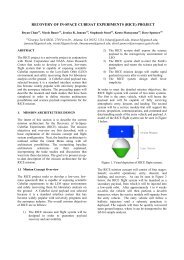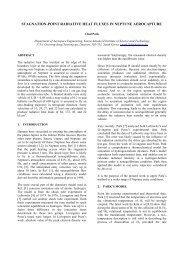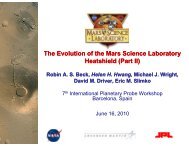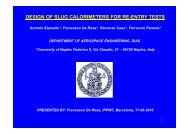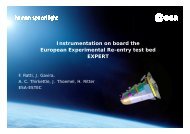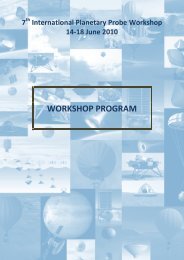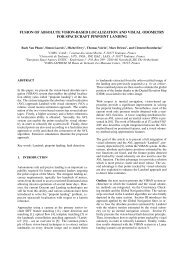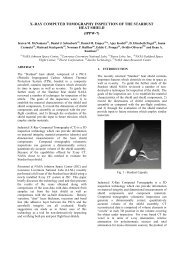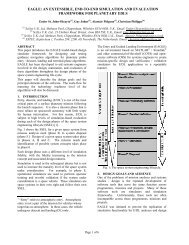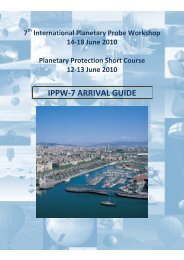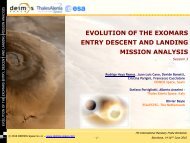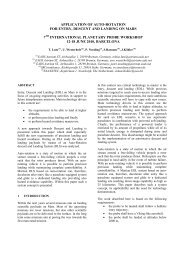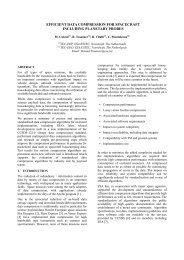Paper 342 - International Planetary Probe Workshop
Paper 342 - International Planetary Probe Workshop
Paper 342 - International Planetary Probe Workshop
You also want an ePaper? Increase the reach of your titles
YUMPU automatically turns print PDFs into web optimized ePapers that Google loves.
lived montgolfière aerial vehicle that would<br />
circumnavigate the moon at a nominal altitude of 10 km<br />
(Fig. 2) and a battery-powered lander targeted at Titan’s<br />
northern lakes (Fig. 3). These probes would be delivered<br />
to Titan by the orbiter spacecraft and supported during<br />
their science mission with two-way data relay through<br />
the orbiter telecom assets (Fig. 4).<br />
The TSSM mission architecture represents a robust and<br />
scientifically rich implementation that would produce a<br />
giant leap in our understanding of Titan and Enceladus.<br />
2. BASELINE MISSION DESCRIPTION<br />
The baseline mission concept developed for TSSM<br />
would include a flight system comprised of an orbiter<br />
and two in situ probes. The flight system would travel<br />
by means of an inner planet gravity assist trajectory and<br />
reach Saturn approximately nine years after launch.<br />
Augmentation of ∆V is provided during roughly the first<br />
two-thirds of the trajectory by using an SEP stage,<br />
which would be jettisoned approximately five years into<br />
the mission (Fig. 5). Following the remainder of the<br />
cruise, the orbiter’s chemical propulsion subsystem<br />
would place the flight system into orbit around Saturn<br />
followed by approximately two years of Saturn system<br />
science, including a minimum of seven Enceladus<br />
flybys, while the flight system would use repeated<br />
satellite gravity assists<br />
Fig. 3. TSSM lake lander concept.<br />
and maneuvers to reduce the energy needed to insert<br />
into orbit around Titan (Fig. 6).<br />
The in situ probes delivered by the orbiter would<br />
include a montgolfière aerial vehicle and a lake lander.<br />
Current planning for the baseline mission is that the<br />
montgolfière probe would be released at the first Titan<br />
flyby after Saturn orbit insertion (SOI) for ballistic entry<br />
into Titan. The lander probe would be targeted and<br />
released at the second Titan flyby to ensure robust<br />
communications links during its primary mission. Titan<br />
orbit insertion would be accomplished at the end of the<br />
Saturn tour phase using the main engine. Capture into<br />
an elliptical Titan orbit would be followed by a twomonth<br />
aerobraking and aerosampling phase, leading to a<br />
circular 1500 km orbit for the final 20-month orbital<br />
science phase (Fig. 7).<br />
At an orbital altitude of approximately 1500 km, the<br />
flight system would orbit Titan approximately five<br />
times in an Earth day. A science planning payload was<br />
developed, consisting of six instruments (Table 1) in<br />
addition to radio science, and was estimated at 165 kg<br />
(including contingency) with an orbital average power<br />
of



